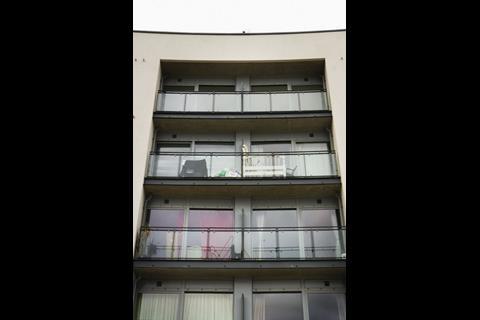Thames Walk was hailed as a model Thames Gateway housing scheme. And so it was – until the buy-to-let investors moved in and the nightmare began. David Blackman investigates.
“It’s a lovely flat, I would just love to take it somewhere else,” says Nona Amoatemaa-Appiah. With a generously proportioned living room overlooking the Thames, the Barratt-built flat is the kind of residence that drooling local estate agents in the Thamesmead area, east London, describe as a “stunning riverside apartment”.
And it’s not only estate agents who have waxed lyrical about the Thames Walk development, where Amoatemaa-Appiah’s apartment is located. On the DCLG website, Thames Walk is hailed as a model Thames Gateway housing scheme. It says the scheme “combines contemporary design with cutting-edge technology and each home incorporates many ecologically friendly devices”.
Unfortunately, as Amoatemaa-Appiah’s comments indicate, the glowing blurb has a decidedly hollow ring for those who live in the area. Talk to a typical Thames Walk resident and a very different picture of the area emerges.
They describe a neighbourhood that is rapidly degenerating into a sink estate barely two years after the first blocks were occupied. Problems range from widespread antisocial behaviour to allegations of systematic mortgage fraud, which has in turn resulted in a string of repossessions.
Concerns have been quietly mounting for some time in housing and regeneration circles that the buy-to-let boom is undermining efforts to create sustainable communities. But nowhere is this downside of the buy-to-let boom more graphically illustrated than in West Thamesmead.
None of these concerns were on the agenda when Thames Walk’s residents began moving in a couple of years ago. “I used to be proud of bringing people here when I bought it. At the E E beginning it was amazing,” says Amoatemaa-Appiah, a freelance TV presenter.
Anne-Marie Griffin invested the whole of a family inheritance in the shared ownership home that she bought from Persimmon Homes in neighbouring Bridge House with her husband Barry. She says: “We thought it was very different from the old-style Thamesmead. Nobody imagined what was going to happen.”
But things turned rapidly sour on Thames Walk. The well-heeled yuppies, working at nearby Canary Wharf, whom the developers may have hoped to attract, were put off by the area’s poor transport links – the nearest fixed rail link is half an hour away on foot. Instead, Amoatemaa-Appiah, who chairs a committee of local residents, says the developers, anxious to offload the development as soon as possible, sold up to small-time landlords who filled the flats with low income tenants. Sitting in her flat, the self-proclaimed “Geordie Ghanaian” winces at the sound of a drill boring through wood in an upstairs flat. She is convinced that yet another of the block’s spacious living rooms is being sub-divided into bedsits.
The litany of complaints about crime and antisocial behaviour in the neighbourhood makes Thames Walk sound like a south England version of Channel 4’s Shameless. These include rubbish being dumped outside rather than inside bin rooms, urinating in public, constant fighting and screaming, and doors and security gates being vandalised. Throughout the summer, gangs of youths were hanging around constantly, making older residents feel nervous about reporting antisocial behaviour. The streets outside the blocks were littered with abandoned and presumably stolen cars. Within eight months of opening, Bridge House was infested with cockroaches as a result of the litter.
Amoatemaa-Appiah complains that the mailboxes in her block have been repeatedly broken into, resulting in a string of ID thefts. She adds that she traded in her car for a less expensive model after a series of break-ins. As for Griffin, she is, she insists, no softie. “I lived on the high street in New Cross for years, but I didn’t see anything as bad as what I’ve seen here.”
The likes of Griffin and Amoatemaa-Appiah blame lack of management by absentee landlords for Thames Walk’s rapid downward spiral. The locally based Gallions Housing Association, which owns and manages the scheme’s shared ownership and social rented units, has been left carrying the can for the problems. Michael Cleaver, Gallions’ head of home ownership, says stereotypes about social housing have been up-ended in West Thamesmead. “The tenants [of the buy-to-let landlords] are not interested in following any sort of rules and it’s difficult to manage their behaviour. At the moment, we have a situation where the social tenants and shared owners feel that they are the people who are bringing any stability to the community and are making an effort to take care of it.”
The tenants of the buy-to-let landlords are not interested in following any sort of rules and it’s difficult to manage their behaviour
Michael Cleaver, Gallions
He says that CPM and Solitaire, the management companies brought in by the scheme’s developers, have been unable to cope with the spiralling problems. “They are not set up to manage schemes where the behaviour of the tenants is causing extreme problems.”
Plans by Persimmon to set up a resident management company have never got off the ground. “Where most of the residents are absentee landlords, it means that they are less likely to be interested in the performance of the managing agents and the running of the management company,” says Cleaver.
Thamesmead MP John Austin has taken up the case of the Thames Walk residents with housing minister Yvette Cooper and the Housing Corporation. He has written to Cooper calling for Persimmon to be taken off the list of private developers receiving social housing grant as a punishment for the way the company has handled Thames Walk.
Thames Walk’s woes have been compounded by allegations that mortgage fraud is rife. Thamesmead had a bad reputation for fraud before Thames Walk capital was built: a recent survey shows that the area is the credit card rip-off capital of London. Rebecca Carnihan, a primary school teacher who bought a shared ownership flat in one of Persimmon’s blocks, says: “A lot of owners have bought the flats with no intention of paying the mortgage, getting the tenants and taking the rent.”
Barratt has reported to the local police allegations that many of its flats were bought by fraudulent investors, using fake IDs to raise mortgages. The fraudsters have then pocketed the cash from often unwitting tenants. As they have not paid a penny to their lenders, many of the flats have already been repossessed and the tenants evicted. Of the 172 flats recently put up for auction by the company EIG, which deals with repossessed properties from across England, five were on the Thames Walk development alone. And this figure is just the tip of the iceberg, according to residents. Amoatemaa-Appiah estimates that up to 40% of the flats in her block have been repossessed.
Residents also allege that much of the mortgage fraud has been committed by Nigerian gangs. A report last year by the international affairs thinktank Chatham House on Nigeria-related fraud said that many of the police raids in connection with such offences had centred on luxury riverside developments in east London.
The neighbourhood’s increasingly poor reputation combined with the mounting tide of repossessions has resulted in the value of flats plummeting, creating a rare pocket of negative equity in south-east England – Thames Walk’s residents reported that the value of their properties has fallen by up to £30,000. The companies that built the blocks are clearly not to blame for the criminal and semi-criminal activity that has gone on there, although residents argue that the way that Thames Walk’s developers went about marketing the scheme left them open to fraud.
Residents say Barratt and Persimmon were over-eager to court investors, offering discounts of up to 15% of the value of the property to those prepared to buy more than one unit. Persimmon sold an entire block at The Pinnacles to a single investor, the Atrex Property Company, which has since been struck off the Companies House register.
A Barratt spokesman insists that its development at Tideham House sold well, while acknowledging that the company was prepared to offer discounts to investors making bulk purchases. Persimmon Homes South East managing director Edward Owens says: “We ensure that the purchaser has the ability to buy the property within an expected timescale from the date of the reservation. The formal procedure we require is a money laundering identity check as required by the Money Laundering Regulations Act 2003. We meet our legal requirements but are always reviewing our procedures to ensure they are as effective as they possibly can be.”
In the meantime, residents and agencies are left to pick up the pieces. Greenwich council is now drawing up a landlord licensing scheme for the Thames Walk area, using recently introduced legislation. The south-east London authority has also asked developers and housing associations to limit the proportion of schemes that it sells to private investors.
A Barratt spokesman insisted that the company was not walking away from the problems at Thames Walk. He said: “Barratt East London is fully aware of the difficulties that have arisen at Thames Walk and other developments in the Thamesmead area, and we have been and continue to make strenuous efforts to resolve the issues where we are able to do so. We are currently discussing the possibility of installing – among other things – a concierge’s office, parking prevention bollards and CCTV cameras.”
Buy-to-let ends up with properties sitting empty or with landlords that don’t have a stake in terms of the community
Pete Challis, local councillor
Pete Challis, a local councillor and former housing spokesman for the Association of London Government, argues that to prevent future Thames Walks, caps should be placed on the proportion of developments sold to investors. Housing Corporation chief executive Jon Rouse says local authorities could use covenants and section 106 agreements to enforce such caps and stronger management arrangements. “Private companies that find themselves in this situation should think of housing associations because they have got the track record and the skills,” he says.
But Challis believes the lessons from Thames Walk stretch far beyond south-east London. In his eyes, they raise profound questions about the buy-to-let boom which has helped to power the explosion of high-density apartments in recent years. “Developers want to do the bulk purchases because they want to shift the properties. We understand that the developers want to make a profit, but the community’s interest is not being served by this approach,” he says.
“If they were selling to individual purchasers, who are going to move into that block, it would be far more sustainable because you’d have people who would have a commitment. The buy-to-let framework ends up with properties sitting empty or with a whole set of landlords that don’t have a stake in terms of the community.”
Gallions’ Cleaver agrees. “The nature of high-density development means that they [developers] have to sell off-plan and quickly. By doing it, they are endangering the long-term supply of the properties that they are developing.”
Other housing associations have encountered problems resulting from the letting out of buy-to-let flats to low income tenants, which has undermined attempts to create mixed communities. Tom Titherington, business development manager of registered social landlord, the Hyde Group, says: “We’ve had instances where homes have been bought by investors and then let to homeless families, which is fine if there’s the management structure to look after them.” He is worried that such problems are being fuelled by the government’s increasing reliance on cross-subsidy from buy-to-let-driven private development to finance estate regeneration schemes.
“Increasingly the regeneration benefits in terms of replacing social housing is being driven by high values. Those high values are being supported by investors buying housing as an investment. … If you are looking for large value returns to pay for the development of the social housing, you may have to accept that developers may have to increase sales targets and to hit those they may have to sell to buy-to-let investors.
“But you can get a mismatch where you are providing a large number of single-bedroom flats, which are the ones that are attractive to the buy-to-let investors. Then you are not getting a mixed community, which the government says they want to have.”
However the Barratt spokesman is keen to dispel any notion that the Thames Walk bad apple is tainting the wider buy-to-let success story. “We do not believe the case of Thames Walk has anything significant to say about buy-to-let, which has revolutionised the way many people plan for their future and old age, or about the wider regeneration of the Thames Gateway. This is a local problem in certain areas of Thamesmead.”
Rouse agrees: “It is true that there have been a small number of mixed developments where an over-provision of buy-to-let properties coming to the market at the same time has led to a higher incidence of antisocial behaviour than one would expect. We shouldn’t forget that a few years ago, we were all arguing that we needed a better private rented sector.”
However, Countryside Properties chairman Alan Cherry, a pioneer of the high-density living boom, believes that housebuilders need to face up to the issues highlighted at Thames Walk. “It doesn’t do anybody any good to have these sorts of problems occurring because it creates a bad reputation. It doesn’t help to sell their product. If you can avoid selling to an investor, particularly a speculator, one would prefer to do that.”
Challis is worried that, unless action is taken, the mega developments being planned in the Thames Gateway will be vulnerable to the same kind of problems suffered by Thames Walk: “If we don’t tackle these issues, we are going to have the same sort of problems on our hands all the way down the Thames Gateway.”
Source
RegenerateLive



























No comments yet